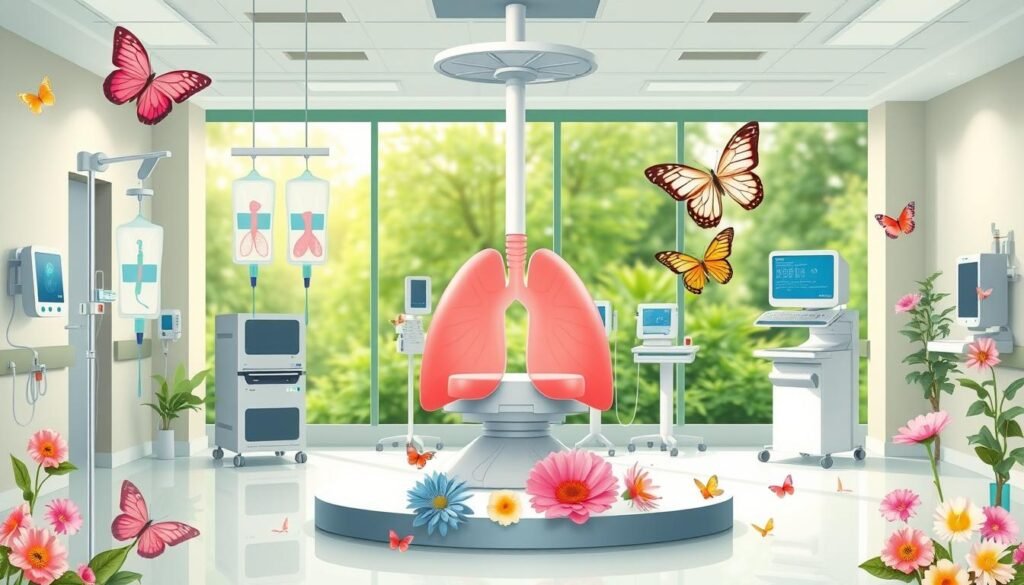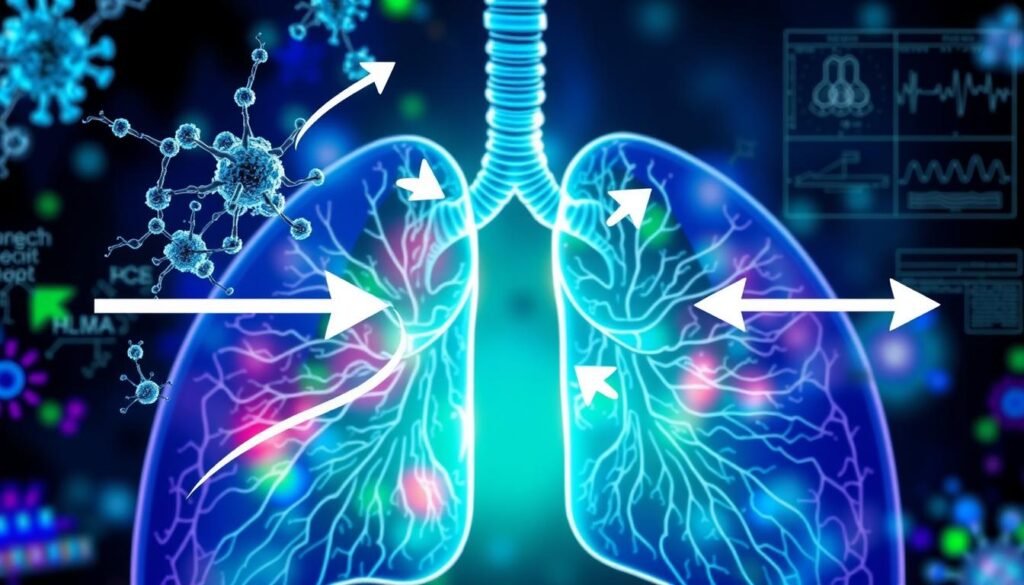Did you know nearly 40% of people with lung cancer find out at stage 4? This shows the need for quick action in diagnosing non-small cell squamous lung cancer stage 4 (NSCLC). This is a tough time for patients and their doctors. The cancer usually spreads far, like to the liver, brain, or bones.
This makes the main goal to help with symptoms and make life better, not so much to cure.
As treatments get better, knowing about stage 4 NSCLC is key. This guide gives details on advanced lung cancer. It talks about symptoms, how to diagnose it, and ways to treat it. It helps patients and their families understand and face this hard time.
Key Takeaways
- Approximately 40% of lung cancer patients are diagnosed at stage 4.
- The overall 5-year survival rate for stage 4 NSCLC is around 4%, with varying rates among different populations.
- Median survival for those with stage 4 non-small cell squamous lung cancer is about eight months.
- Genetic mutations play a crucial role in treatment, with therapies like Rybrevant targeting specific mutations.
- Imaging tests and tissue biopsies are essential for accurate diagnosis and evaluation of the cancer’s progression.
- Effective treatment plans focus on symptom management and improving quality of life for patients facing terminal lung cancer.
- Supportive care, including emotional and pain management, is vital for enhancing comfort and life quality.
Understanding Non Small Cell Lung Cancer
Non-small cell lung cancer (NSCLC) starts from epithelial cells. It includes various types based on cell traits and growth. NSCLC is generally less aggressive than small cell lung cancer. It forms the bulk of lung cancer cases.
What is Non Small Cell Lung Cancer?
Non-small cell lung cancer isn’t small cell carcinoma. This distinction matters for treatment and outcomes. It begins in the lung tissue. Risk factors include smoking and environmental exposures.
Types of Non Small Cell Lung Cancer
NSCLC has three main types:
- Squamous Cell Carcinoma: Linked to smoking, it starts in the lungs’ central part.
- Adenocarcinoma: Found in the lungs’ outer areas, it’s more common in non-smokers.
- Large Cell Carcinoma: This rare type can grow anywhere in the lung quickly.
Spotting early signs of NSCLC is key for early treatment. Signs like a lasting cough, losing weight without trying, or breathing trouble are crucial. To learn about the first signs, click here. Early action can greatly help in treatment and improving life quality.
What is Stage 4 Non Small Cell Squamous Lung Cancer?
Stage 4 non-small cell lung cancer (NSCLC) is the most serious level of this illness. It’s when the cancer travels to far parts of the body. This is known as metastatic squamous NSCLC. It’s crucial to comprehend lung cancer’s categorization for better treatment and outlook.
The Staging of Lung Cancer
The staging system for lung cancer has six levels. It starts from an occult stage and goes up to stage 4. The stage shows how far the cancer has spread and affects treatment choices:
- Occult Stage: Cancer exists but hasn’t shown up on scans yet.
- Stage 0: Called carcinoma in situ, with cell changes still in one place.
- Stage 1: Broken down into 1A and 1B, based on tumor size and if lymph nodes are involved.
- Stage 2: This is 2A and 2B, looking at tumor size and lymph nodes.
- Stage 3: Comes in three forms—3A, 3B, and 3C. It depends on tumor size and where the cancer has spread to lymph nodes.
- Stage 4: Divided into 4A and 4B, showing different spread patterns.
About 8% is the survival rate for distant lung cancer.
This highlights the seriousness of the prognosis for stage IV non-small cell lung cancer.
Symptoms of Stage 4 NSCLC
Those with late-stage non-small cell lung cancer might have several hard symptoms, such as:
- Coughing that gets worse.
- Chest pain that grows when you breathe.
- Weight loss without trying.
- Dyspnea, or trouble breathing.
Noticing these lung cancer symptoms early can help get quicker medical help. Recognizing these signs early can improve care and treatment. Check out this resource on stage 4 lung cancer for more information.
Diagnosis of Stage 4 Non Small Cell Squamous Lung Cancer
Getting diagnosed with stage 4 non-small cell squamous lung cancer (NSCLC) requires a detailed process. Doctors use many tests to accurately find out how far the cancer has spread. It is vital to know this early on because the cancer has already moved beyond its starting point.
Diagnostic Tests and Procedures
Doctors use several diagnostic tests when they think someone has stage 4 lung cancer. Important tests include:
- Chest X-rays: These images help spot unusual signs in the lungs.
- CT Scans: CT scans give a clearer picture of the chest than X-rays. They show how far the cancer cells have spread.
- Biopsies: Taking tissue samples to check for cancer type and presence under a microscope.
- Pulmonary Function Tests: These tests measure lung performance. They help doctors plan the treatment by assessing lung health.
Importance of Accurate Pathological Assessment
An exact pathological assessment is crucial to confirm the type and stage of lung cancer. Wrong diagnoses can lead to the wrong treatments, negatively affecting the patient’s chances. Pathologists play a key role in looking at the tests to ensure the cancer is classified correctly. This step is critical to choose the best treatment. Early diagnosis and careful pathology review positively affect the patient’s care plan and future health.
Treatment Options for Stage 4 Non Small Cell Squamous Lung Cancer
Stage 4 non-small cell squamous lung cancer (NSCLC) treatment mainly aims at palliative care. It focuses on easing symptoms and boosting the quality of life for those with advanced cancer. Every treatment plan is tailored, considering the patient’s health, the tumor’s traits, and how much the cancer has grown. Patients work closely with a team of healthcare professionals to make treatment decisions.
Overview of Treatment Goals
Treating palliative lung cancer focuses on reducing symptoms like cough, difficulty breathing, and pain. Some common methods include:
- Chemotherapy using cisplatin or carboplatin along with gemcitabine.
- Targeted therapies such as erlotinib or crizotinib, depending on specific gene mutations.
- Immunotherapies like pembrolizumab and nivolumab that help the body fight cancer.
Factors Influencing Treatment Decisions
Many factors influence the choice of treatment for stage 4 NSCLC patients. Important points to consider are:
- Genetic Mutations: Finding specific mutations like EGFR or ALK may lead to targeted treatment options.
- General Health: The patient’s overall health and other existing conditions matter when choosing a treatment.
- Disease Progression: Knowing the stage and spread of the disease is critical for treatment decisions.
For more detailed information on treatment choices, check out internal resources on lung cancer treatment.

| Treatment Type | Medications/Methods | Indications |
|---|---|---|
| Chemotherapy | Cisplatin + Gemcitabine | Stage 4 treatment |
| Targeted Therapy | Erlotinib, Crizotinib | Based on genetic mutations |
| Immunotherapy | Pembrolizumab, Nivolumab | Enhance immune response |
| Palliative Care | Symptom management | Focus on quality of life |
Chemotherapy for Advanced NSCLC
Chemotherapy is key in treating advanced non-small cell lung cancer (NSCLC). The choice of chemotherapy regimens depends on the cancer stage and patient specifics. Often, chemo helps shrink tumors before surgery or kill leftover cancer cells afterwards. When surgery isn’t possible for locally advanced NSCLC, doctors might combine chemo with radiation. In cases of widespread disease, chemo is the main treatment, aiming at cancer spread beyond the lungs.
Common Chemotherapy Regimens
There are several common drugs for advanced NSCLC:
| Drug | Use |
|---|---|
| Cisplatin | Often used in combination with other drugs |
| Carboplatin | Commonly combined with Paclitaxel or Gemcitabine |
| Paclitaxel | Typically paired with Cisplatin |
| Docetaxel | Used as both an initial treatment and a second-line option |
| Gemcitabine | Often in combination regimens |
| Pemetrexed | Used alone or with other agents depending on the patient |
These treatments happen in three to four-week cycles. Early stages might see drug combinations, while single drugs could suit those at a later stage better. Initial therapy generally involves four to six cycles, followed by maintenance for positive responders.
Risks and Side Effects of Chemotherapy
Side effects of treatment are something patients need to know. They might feel nauseous, lose hair, feel tired, have mouth sores, changes in appetite, or get infections easier due to weaker immunity.
Some chemos can cause nerve damage or peripheral neuropathy, leading to burning feelings or weakness. But many side effects can be controlled with a good cancer care team. Reporting side effects early ensures quick and effective treatment.
For deeper insight into chemo options, visit the National Cancer Institute.
Targeted Therapy for Squamous NSCLC
Targeted therapy is a breakthrough in treating squamous non-small cell lung cancer (NSCLC). It focuses on the disease’s specific genetic mutations. By identifying these mutations, doctors can tailor cancer treatment better. This improves patient outcomes and life quality.
Understanding Genetic Mutations in Lung Cancer
Genetic mutations are key in lung cancer’s progression. They determine how effective treatments can be. Around 5% of NSCLCs have an ALK gene rearrangement. This is more common in non-smokers or those who smoke a little. The KRAS G12C mutation is found in about 12% of NSCLC cases. This offers another therapy target.
ROS1 mutations are found in 1% to 2% of cases, mostly in adenocarcinoma subtypes. Knowing these mutations is crucial for effective targeted therapy in squamous NSCLC.
Specific Targeted Treatments Available
Several targeted treatments are designed for NSCLC’s specific mutations. EGFR inhibitors, like gefitinib and erlotinib, work well for those with EGFR-positive tumors. For patients with ROS1-positive diseases, crizotinib and entrectinib are good options. Sotorasib is a new treatment for those with the KRAS G12C mutation.
Targeted therapies usually cause fewer side effects than traditional chemotherapy. This makes the cancer treatment phase better for patients.

Palliative Care and Supportive Treatments
Palliative care is crucial for people with stage 4 lung cancer. It aims to make life better by managing symptoms and offering emotional support. Various treatments help ease discomfort and boost well-being during the illness.
The Role of Palliative Care in Stage 4 Cancer
This care isn’t just for the end of life. It helps at any stage, no matter the outlook. A team of doctors, nurses, and social workers provide this support. They make sure the care meets the unique needs of each person.
Managing Symptoms and Improving Quality of Life
There are treatments to lessen symptoms lung cancer patients face, such as:
- Pain management
- Stress reduction
- Relief from shortness of breath
- Help with fatigue
Some may need thoracentesis or pleurodesis to remove fluid in the chest. Treatments like photodynamic therapy can open airways blocked by tumors.
But palliative care isn’t just physical. It also supports emotional and mental health. It helps patients deal with their diagnosis and its challenges. Tracking symptoms lets patients talk clearly with their doctors, getting timely care.
| Symptom | Supportive Treatment | Care Setting |
|---|---|---|
| Pain | Pain relief medications | Hospital, clinic, home |
| Difficulty breathing | Thoracentesis, stent placement | Hospital, specialized center |
| Nutritional needs | Nutritional supplements | Home, outpatient |
| Psychological distress | Counseling and support groups | Hospital, online, community |
Good communication makes a big difference in the patient’s experience. It makes sure treatments really help improve life quality with lung cancer.
Clinical Trials and Research Opportunities
Clinical trials are key for advancing cancer treatment. They let patients try new treatments that aren’t yet widely available. These trials are especially crucial for stage 4 non-small cell lung cancer (NSCLC) patients.
What Are Clinical Trials?
Clinical trials test new treatments on people to see if they’re safe and effective. They’re central to finding better options than what’s currently available. Each trial phase collects specific information about treatment effects, dosages, and side effects.
Importance of Participation in Research
Joining cancer studies has big benefits. It gives patients access to the latest treatments. It also helps improve our understanding of lung cancer and leads to new treatments. Doctors urge patients to talk about clinical trials that might be right for them.

| Trial Phase | Description | Example Treatments |
|---|---|---|
| Phase I | Initial studies to evaluate safety, dosage, and side effects | MYTX-011 (antibody drug conjugate) |
| Phase II | Focused on effectiveness and further safety evaluation | Treatment combinations (carboplatin + gemcitabine) |
| Phase III | Comparative studies with established treatments | Crizotinib for ALK mutation lung cancer |
Patients are encouraged to learn about studies of new treatments, like targeted therapies and immunotherapies.
Living with Terminal Lung Cancer
Living with lung cancer brings emotional and physical challenges. Patients and their families adapt and show resilience. They navigate life with terminal lung cancer, seeking understanding and community support.
Navigating Life with Advanced NSCLC
Patients with advanced NSCLC face symptoms that impact daily life. They must manage pain and fatigue. A balanced routine with rest and gentle activity improves life.
Emotional support is crucial for dealing with the diagnosis. Families and caregivers must express feelings and find helpful resources. This support helps everyone on this journey.
Support Resources Available
Patients and families have many support resources. These include counseling, support groups, educational materials, and palliative care. Each offers unique help.
- Counseling services that provide a safe space for emotional expression.
- Support groups that foster connection among individuals facing similar challenges.
- Educational materials offering insights into advanced NSCLC and symptom management.
- Palliative care programs that focus on comfort rather than curative treatment.
Using these resources can improve the experience of living with lung cancer. Open discussions about needs lead to care that uplifts spirits. This helps build resilience against lung cancer’s challenges.
| Support Resource | Description |
|---|---|
| Counseling Services | Professional guidance for emotional and psychological support. |
| Support Groups | Networking with others affected by lung cancer for shared experiences. |
| Educational Materials | Books and online resources explaining lung cancer treatment and coping strategies. |
| Palliative Care Programs | Holistic care focused on improving the quality of life for patients. |
Importance of Ongoing Monitoring and Follow-up
For patients with stage 4 non-small cell squamous lung cancer, monitoring is key. Regular check-ups help healthcare providers measure how well a treatment is working. They also make timely changes to improve patient results. Following established guidelines makes sure patients get the right care they need.
Regular Assessments and Their Significance
Monitoring a patient involves different kinds of tests, like imaging and checking symptoms. The National Comprehensive Cancer Network (NCCN) suggests regular chest CT scans for those getting initial treatment. These tests spot any tumor changes or new symptoms early. This helps to catch a possible return of the cancer or other issues sooner.
Adjusting Treatment Based on Response
Seeing how patients react to treatment is crucial for making changes in their care plan. If a patient’s condition doesn’t improve much or if they have negative side effects, their treatment might be changed. This flexible approach increases the treatment’s success for stage 4 non-small cell squamous lung cancer patients.
| Assessment Type | Frequency | Purpose |
|---|---|---|
| Chest CT Scan | Every 6 months for initial years, then annually | Evaluate tumor size and detect any new developments |
| Symptom Evaluation | As needed, at each follow-up visit | Assess patient comfort and identify side effects |
| Blood-based Biomarkers | Periodic assessment | Determine treatment effectiveness and need for adjustments |
Cancer monitoring is a fundamental part of follow-up care, ensuring timely changes for better results. It’s critical for helping patients with stage 4 non-small cell squamous lung cancer improve.
Conclusion
Managing stage 4 non-small cell squamous lung cancer is tough but important. This stage means the disease has grown a lot. It affects how long patients might live and their quality of life. About 25% to 30% of people may live less than three months after diagnosis. Yet, some patients live much longer. This shows why finding and treating the cancer early is crucial.
The treatment for this kind of lung cancer includes many options. Patients might get chemotherapy, targeted therapies, or care to ease symptoms. The goal is to make them feel better and fit the treatment to what they need. What treatments work best can depend on the kind of tumor and the patient’s health. This highlights how each patient’s care plan should be unique to them.
Knowing all about stage 4 non-small cell squamous lung cancer helps patients and their families better face this challenge. Despite tough stats, new treatments and care methods bring hope. They can improve the chances for many dealing with this condition.